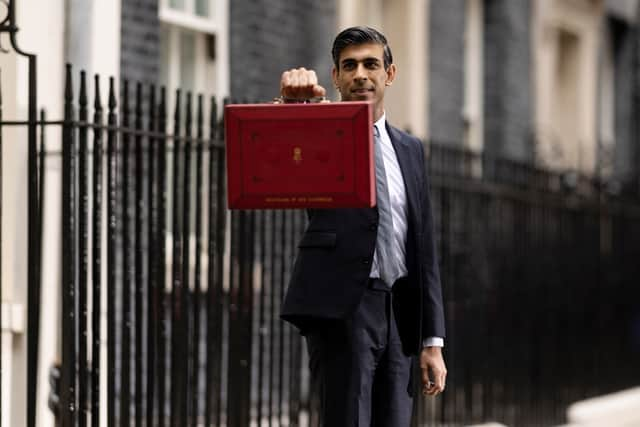When do National Insurance contributions change? Date new rates start, how much NICs tax cut will save
and live on Freeview channel 276
Liz Truss has been forced to scrap most of her economic agenda since her government’s mini budget led to major market turmoil.
New Chancellor of the Exchequer Jeremy Hunt has scaled back the swathe of tax cuts announced by his predecessor Kwasi Kwarteng, with the announcement of a delay to the planned cut in income tax and confirmation corporation tax will no longer be frozen.
Advertisement
Hide AdAdvertisement
Hide AdGiven the cost of public borrowing has risen dramatically since the original mini budget, it is now expected Hunt will announce major government spending cuts. He has already scaled back the Prime Minister’s headline Energy Price Guarantee policy by 75%.
While it means almost all of Downing Street’s plans for dealing with the cost of living crisis and the threat of a UK recession have been abandoned, two big measures remain in place: the stamp duty cut and a reversal of Rishi Sunak’s National Insurance hike. But when will National Insurance Contributions change? Here’s what you need to know.


What is National Insurance?
National Insurance is a tax most working people pay out of their monthly salary. Known as National Insurance contributions (or NICs for short), the money we give to the government is used to fund state pensions as well as key benefits, like Universal Credit.
What you pay in NICs depends on how much you earn and whether you’re employed or self-employed. Everyone can take home a certain amount of their pay before they have to pay any National Insurance - something which is known as the National Insurance threshold.
Advertisement
Hide AdAdvertisement
Hide AdWhen Boris Johnson was in office, his Chancellor Rishi Sunak said the government would have to increase NICs to pay for the huge public spending drive it launched during the Covid-19 pandemic to cover the furlough scheme and other state support. It proved to be a hugely unpopular move among Conservative backbench MPs.


From April 2022, workershad to pay an extra 1.25% in National Insurance, meaning the tax took 13.25% of your taxable income rather than the 12% it previously did.
In April 2023, the plan was for this extra sum to become a health and social care levy - a ringfenced fund Johnson and Sunak said would be used to clear the Covid backlog in hospitals and pay for social care.
But, with the cost of living crisis getting worse and political pressure for more government action, the then-Chancellor was forced to increase the NI threshold from £9,880 to £12,570 for people categorised as Class 1 (employed) and Class 4 (self-employed).
Advertisement
Hide AdAdvertisement
Hide AdYou still had to pay a rate of 13.25% on anything earned between the new threshold and £50,270, while any salary over £50,270 would continue to be charged at 3.25%. But it was effectively a tax cut for low-to-medium earners.


How will NICs change?
Liz Truss made cutting the overall hike to National Insurance one of her key Conservative leadership campaign pledges. Kwasi Kwarteng duly announced the reversal in his 23 September mini budget - although the pair kept the higher threshold in place.
The move means around 28 million workers across the UK - more than two-thirds of the UK workforce - will save an average of £330 a year (£27.50 a month) by 2023-24, with savings of around £135 over the next year, according to the Treasury.


It also means that businesses will get to keep more of their earnings, which ministers hope will insulate them against a possible recession and trickle down to help workers with the rising cost of living. Around 920,000 businesses will save almost £10,000 on average next year thanks to the change, the treasury says.
Advertisement
Hide AdAdvertisement
Hide AdAt the same time as cutting the tax, Liz Truss has said money will still be set aside to fund the NHS and social care as per Rishi Sunak’s pledge.
When will National Insurance rate change?
The National Insurance tax cut was pushed through the House of Commons on 12 October, just days before Kwasi Kwarteng was sacked as Chancellor.
The new rate for NICs is set to come into effect on 6 November 2022. It means you should see a change to your paypacket for November, although some people may receive the cut in a backdated format between December 2022 and January 2023 due to how complex payroll software systems are.


Basic rate taxpayers will get an average of £75 back in the 2022-23 tax year, rising to £175 in 2023-24. Higher rate taxpayers will gain approximately £300 on average before April 2023, rising to £700 over the next 12 months.
To see how much money you’ll be getting back, consumer website Which? has a National Insurance calculator.
Comment Guidelines
National World encourages reader discussion on our stories. User feedback, insights and back-and-forth exchanges add a rich layer of context to reporting. Please review our Community Guidelines before commenting.
